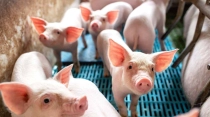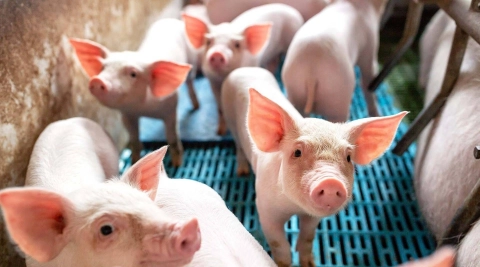Healthy living Antibiotic resistance – what role is played by the environment?
Antibiotics are used to treat bacterial infections in humans and animals. Bacteria that enter the environment from sewage or manure, for example, can facilitate the emergence and spread of antibiotic-resistant bacteria.
At a glance
- Bacteria may be naturally resistant to certain antibiotics or may acquire antibiotic resistance.
- Antibiotics can enter the environment from livestock farming or from hospitals.
- Antibiotics in the environment can result in the development of antibiotic resistance.
- Sewage plants provide an ideal environment in which bacteria can pass on their resistance genes to other bacteria that were previously non-resistant.
- It is usually difficult to treat someone who contracts an infection with an antibiotic-resistant bacteria.
- To avoid resistance, it is important to take an informed and responsible approach to antibiotics in all areas of life.

What is antibiotic resistance?
Antibiotics are used to treat bacterial infections in humans and animals. They inhibit or kill disease-causing bacteria and support recovery. If bacteria are resistant to antibiotics, in other words, insensitive to them, this makes effective treatment of the infection difficult in most cases. In particular, multi-resistant bacteria – those that are insensitive to several different classes of antibiotic – present a major problem.
If they are treated with an antibiotic, the resistant bacteria may continue to multiply, while non-resistant – and, in some cases, helpful – bacteria are killed. In this way, antibiotic-resistant bacteria have a survival advantage over non-resistant bacteria. This can result in an imbalance in the natural bacterial population.
Some types of bacteria are naturally resistant to certain antibiotics. However, there are also many bacteria that, over time, have gradually become insensitive to previously effective antibiotics. This occurs in particular if antibiotics are taken too frequently, without good reason or without following the instructions provided by the prescribing doctor.
If antibiotics enter the environment, for example, through the sewer system or from agricultural sources, this can also facilitate the emergence of antibiotic-resistant bacteria.
How do antibiotics enter the environment?
Human and animal sources
Antibiotics are not completely broken down by the metabolic processes in the bodies of humans and animals. This means that they are, in part, excreted in urine and feces – up to 90 percent of some types of antibiotic may be excreted.
Antibiotics, antibiotic residue and antibiotic-resistant bacteria enter the environment primarily through the excretions (urine and feces) of humans and animals. The main routes for this to happen are through the spreading of animal manure, sludge or fermentation residue from biogas plants on fields and the discharge of waste water from municipal sewage plants or health facilities such as hospitals.
Antibiotic residue can enter the sewer system with sewage and, from there, make its way to sewage plants. Most sewage plants are not currently capable of completely containing micro-impurities, including antibiotics. This means that antibiotic residue can enter sewage sludge, which is often spread on fields as a fertilizer. It can also enter the sewage plant’s waste water, some of which ends up in lakes and rivers.
Antibiotic residue from livestock farming can also enter the environment. If an animal is treated with antibiotics, the residue can end up in fields, meadows and water bodies by being excreted directly in the animal’s feces (on free-range farms) or through the spreading of animal manure and dung on fields. From there, it can also enter the groundwater.
However, antibiotics are found primarily in surface waters and more rarely in groundwater. In drinking water purification plants, steps are taken to ensure that antibiotic residue and bacteria are eliminated from the water. This means that there’s no need to worry about drinking water quality.
Manufacturing sources
In some countries, such as India, waste water from manufacturing plants often contains large quantities of antibiotics, which enter the environment this way. Manufacturing plants are therefore one of the main causes of antibiotics entering water and soil in those countries. In Germany, on the other hand, this entry route does not play a significant role.
Foreign travel
The consumption of antibiotics is much higher in many countries than in Germany. There are more resistant and multi-resistant bacteria in those countries as a result.
Due to globalization and (long-haul) travel, antibiotic-resistant bacteria from countries with high resistance rates can be imported into Germany. In South and Southeast Asia, for example, resistant and multi-resistant bacteria are widespread, and so there is a high risk of travelers from Germany picking up such bacteria there and carrying it home with them. Around 70 percent of travelers returning from countries such as India and Laos bring back multi-resistant microbes with them.
What happens after antibiotics enter the environment?
Antibiotics that enter the environment inhibit environmental bacteria that are sensitive to antibiotics, while also facilitating the development of new antibiotic resistance. That’s because resistant bacteria have a clear survival advantage over non-resistant bacteria when exposed to antibiotics. Small concentrations of antibiotics are sufficient to enable the development of resistance.
In addition, bacteria that are already resistant can pass on their resistance genes to other types of bacteria that were previously non-resistant. Waste water from sewage treatment plants, sewage sludge and manure are all ideal mediums in which this can occur because bacterial populations in this material are particularly dense and they also provide a good source of nourishment for the bacteria. When sewage sludge and manure is spread on fields and waste water from sewage treatment plants is discharged into bodies of water, the environmental bacteria that live there can also develop resistance. As a result, there is a risk that ever-increasing numbers of environmental bacteria will become resistant to antibiotics.
How are bacteria from the environment transmitted to humans?
In general, the transmission of resistant bacteria from the environment to humans has a more minor role to play. Much more commonly, bacteria are transmitted from human to human, from animal to animal, or between animals and humans – in particular in hospitals and care facilities and in livestock farming.
Nevertheless, the transmission of bacteria (both resistant and non-resistant) from the environment to humans is, in principle, possible in any location where people come into contact with heavily contaminated water or soil. This is the case, for example, if people bathe in water bodies with poor water quality or eat unwashed foods (such as salads) that were watered with contaminated water.
In general, though, it is pretty unlikely for someone to ingest enough bacteria in this way to contract an infection. A very large quantity of bacteria is normally required in order for this to happen. Healthy individuals should normally have no reason to worry about bathing in water of good to excellent water quality.
In any case, most environmental bacteria are not pathogenic, that is, disease-causing. This means that, even if they enter a person’s body and start to reproduce there, they won’t make that person sick. Under certain circumstances, however, these bacteria may pose a problem. If, for example, resistant bacteria from the environment begin to colonize the intestines, they may pass on their antibiotic-resistant genes to the other intestinal bacteria there. In people with a weakened immune system, these intestinal bacteria can cause an infection that can be difficult to treat because of antibiotic resistance. As a precautionary measure, it is advisable to avoid bathing in natural bodies of water.
Video What is the microbiome?
Watch this video to find out more about the microbiome and its functions in the human body.
This and other videos can also be found on YouTube
Watch nowThe privacy policy indicated there applies.
Video How can foodborne infections be prevented?
The following video explains what can be done to prevent foodborne infections.
This and other videos can also be found on YouTube
Watch nowThe privacy policy indicated there applies.
What can be done to prevent the spread of antibiotic resistance?
One Health
The “One Health” approach is central to the fight against antibiotic resistance. After all, the health of humans, animals and the environment are all closely intertwined. Looked at this way, there is only one health to be protected and so a single, unified approach has to be taken across all areas. Pathogens – disease-causing germs – know no boundaries and can spread between people, animals and the environment.
Therefore, measures to prevent antibiotic resistance must be applied in human and veterinary medicine, as well as in agriculture and environmental policy. In addition to helping combat antibiotic resistance, the One Health approach is also important in other areas, such as containing the spread of zoonotic diseases. More than half of all pathogens are zoonotic, which means that they can be transmitted from animals to humans.
Antibiotic resistance strategy
A number of strategies have already been formulated to combat the growth of antibiotic resistance. Foremost among these is the Global Action Plan on Microbial Resistance, which was developed by the World Health Organization (WHO) and is implemented at a national level in Germany by means of the German Antibiotic Resistance Strategy (“Deutsche Antibiotika-Resistenzstrategie”, or DART for short). Among other things, it envisages the monitoring and recording of antibiotic consumption and resistance, as well as measures to prevent infection and to ensure correct, appropriate use of antibiotics and increased research activities. In accordance with the One Health approach, these measures apply to both human and veterinary medicine.
Major successes have already been achieved in veterinary medicine. The quantities of antibiotics used in farming have been significantly reduced, with a drop of 60 percent recorded between 2011 and 2019. In human medicine too, doctors are now using fewer antibiotics – in outpatient settings, antibiotic use was reduced by about one fifth between 2010 and 2018. If fewer antibiotics are used, fewer will be able to enter the environment.
Improvements in sewage plant technology
Efforts are also being made to improve sewage plant technology so that antibiotic residue can be filtered out. Effective methods have already been identified. For example, many antibiotic active agents can be removed using ozone and activated carbon.
Everyone has a part to play
To avoid becoming infected with bacteria from the environment, be sure to only bathe in natural bodies of water that are known to have a high quality of water. Good food preparation hygiene can also help prevent infection. For example, be sure to wash fruit and vegetables thoroughly before eating them.
To find out how everyone can play their part in reducing the number of new antibiotic-resistant pathogens that can develop, read the article discussing antibiotic resistance.
- Adler N, Balzer F et al. Antibiotika und Antibiotikaresistenzen in der Umwelt: Hintergrund, Herausforderungen und Handlungsempfehlungen. Umweltbundesamt. 11.2018.
- Bundesamt für Verbraucherschutz und Lebensmittelsicherheit. Abgabe an Antibiotika in der Tiermedizin sinkt weiter. Aufgerufen am 22.04.2021.
- Bundesregierung. DART 2020: Antibiotika-Resistenzen bekämpfen zum Wohl von Mensch und Tier. 1. Auflage. Mai 2015.
- D’Souza AW, Boolchandani M, Patel S et al. Destination shapes antibiotic resistance gene acquisitions, abundance increases, and diversity changes in Dutch travelers. Genome Medicine 2021. 13: 79. doi: 10.1186/s13073-021-00893-z.
- Holstiege J, Schulz M, Akmatov MK et al. Rückgang der ambulanten Antibiotika-Verordnungen. Deutsches Ärzteblatt 2020. 117: 679-686.
- Kantele A, Kuenzli E, Dunn SJ et al. Dynamics of intestinal multidrug-resistant bacteria colonisation contracted by visitors to a high-endemic setting: a prospective, daily, real-time sampling study. The Lancet 2021. 2: e151-158. doi: 10.1016/S2666-5247(20)30224-X.
- Westphal-Settele K, Konradi S, Balzer F et al. Die Umwelt als Reservoir für Antibiotikaresistenzen. Bundesgesundheitsblatt 2018. 61: 533-542.






